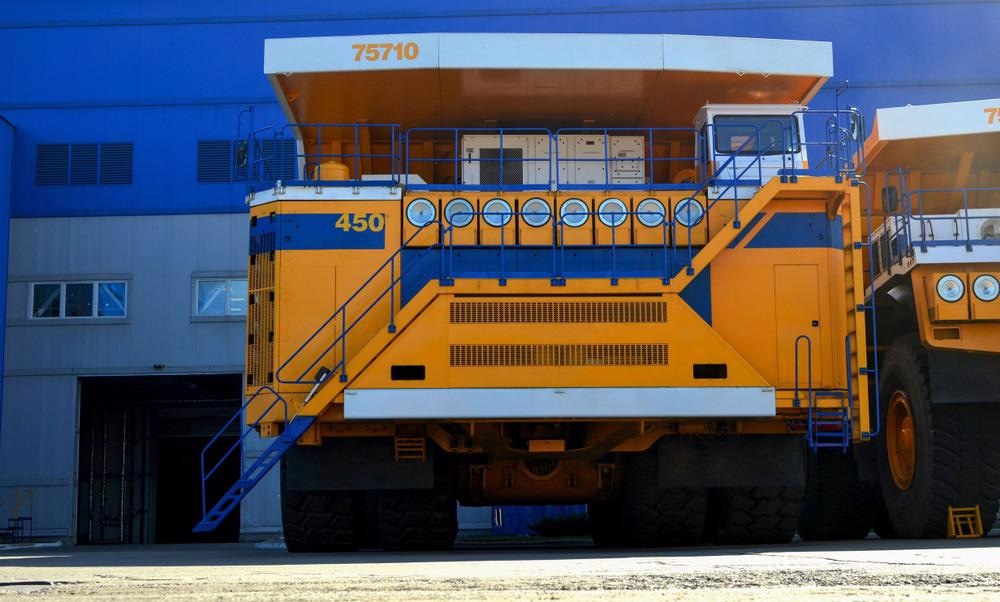The mining industry has been adopting more heavy-duty battery electric vehicles, machinery, and transportation systems to reduce CO2 emissions and fossil fuel dependency, increase flexibility and efficiency in mining operations, and improve worker safety. Mining electrification is also enabling more automation in mines and a shift toward digitalization.

Electrification in the mining sector is gaining traction due to a growing need to decarbonize machinery and vehicles. Image Credit: Maksim Safaniuk/Shutterstock.com
For decades, the heavy industry has relied on diesel power to drive rugged machinery, giant trucks, and bespoke transportation systems that make mines work. This brings many challenges and risks to mining operations.
Excess heat and exhaust fumes from heavy diesel engines require extensive ventilation systems to be put in place in underground mines. Noise and vibration protection is also required for the structural integrity of tunnels and shafts, mechanical wear of parts and vehicles, and for the health and safety of workers.
Highly powered diesel engines are heavy and bulky, so vehicles and machinery must be hefty enough to accommodate them. This in turn means that tunnels must be larger, and so are more difficult and costly to excavate. Refueling requirements also limit the mine’s infrastructure and smooth operation.
All these challenges combine with the costs of fuelling and maintaining heavy-duty diesel engines and mining equipment. A mine’s return on investment is tied to fuel costs outside of the operator’s control, and costs for maintenance and replacement of bespoke parts eat into profits.
Why are Mines Around the World Moving to Electrification?
Electrifying fleets of transportation vehicles, haulage trucks, and mining machinery and gear resolves the challenges caused by using heavy diesel engines in mining.
No exhausts, much less excess heat, and much less sound and vibration in battery electric vehicles make them far safer to work with underground than diesel-powered alternatives.
Converting to electric power and installing solar, wind, or geothermal renewable energy capture systems reduces mining’s environmental impact by removing a source of CO2 emissions. On-site renewable energy generation coupled with an electrified mining operation also drastically reduces energy costs.
Energy costs make up roughly 30% of an average mining firm’s total expenditure. Investment in electrification and renewable energy capture can, therefore, significantly improve mining companies’ long-term profitability. This reduction in energy costs would also come alongside reduced maintenance costs for heavy-duty diesel engines and equipment.
Bird in The Mine - Customer Benefits of Electrification
Video Credit: Sandvik/YouTube.com
Autonomous Vehicles in Mining
Electrification also makes it much easier to develop autonomous mining operations. Electric vehicles can more easily be fitted with the sensors and on-board AI needed to function autonomously or semi-autonomously.
Unmanned mine and autonomous mining operations are a widespread trend that is beginning to take hold in the mining industry. Benefits include increased worker safety and the possibility of mining in more remote and extreme environments.
Efficiency gains are also achieved with AI optimizing every possible factor in the mining operation, from charging cycles to turning circles.
Despite these advantages, the mining sector has been relatively slow to adopt electrification. This is in part due to the industry’s historical reliance on diesel power, and the expense of decommissioning and replacing heavy-duty equipment.
The industry is also known for being conservative in outlook and cautious about adopting new technologies and approaches. However, as is the case in construction and other conservative industries, the rapid advancement of new digital technologies necessitates mining to learn to embrace change faster.
To ease the transition, a new generation of hybrid diesel-electric trucks has been introduced to help the industry move towards electrification in a commercially viable, stepwise manner. Typical diesel mining trucks burn through around 300 l of fuel per hour and have tank capacity for 10 hours of continuous operations. Hybrid diesel-electric trucks, however, only use around 30 l of fuel per hour.
Where is Mining’s Electric Revolution Going Next?
Widespread and total electrification in the mining industry will require more than just installing batteries and electric motors onto current equipment. New electric mining vehicles and machinery will take advantage of the unique strengths of electric vehicles, such as more design freedom, reduced form factor, and integration with sensors and AI.
These new designs will in turn impact mining operations on a bigger scale as well. Charging and battery swapping methods, on-site renewable energy capture, route mapping, blast and excavation operations, and internal infrastructures such as roads, ramps, and tunnels can all be optimized for electric power.
The economic and environmental benefits that electrification can bring to mining have not yet been fully realized, as the transition toward electric power is still in its first phase – early adopters.
However, COVID-19 and other challenges such as the need to decarbonize, dwindling mineral resources, and volatile fuel costs are all contributing to an increase in the pace of change in the industry. The electrified future of mining will come a lot sooner than some may expect.
References and Further Reading
Goosen, M. (2021). The Future of Mining Through Electrification, Digitalization and Automation. Energy Capital and Power. Available at: https://energycapitalpower.com/the-future-of-mining-through-electrification-digitalization-and-automation/.
Mining – where electrification meets innovation. TechCrunch. Available at: https://techcrunch.com/sponsor/sandvik/mining-where-electrification-meets-innovation/.
Pilkington, B. (2021). Driving Sustainability Forward in Mining with Electric Vehicles. AZO Mining. Available at: https://www.azomining.com/Article.aspx?ArticleID=1580.
Disclaimer: The views expressed here are those of the author expressed in their private capacity and do not necessarily represent the views of AZoM.com Limited T/A AZoNetwork the owner and operator of this website. This disclaimer forms part of the Terms and conditions of use of this website.